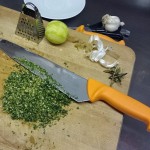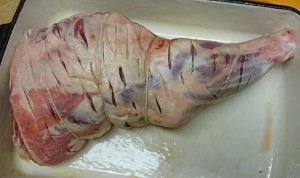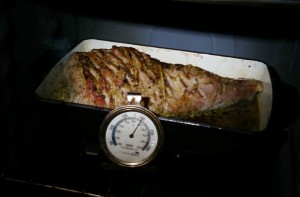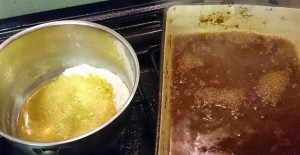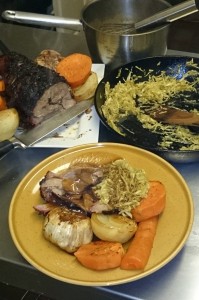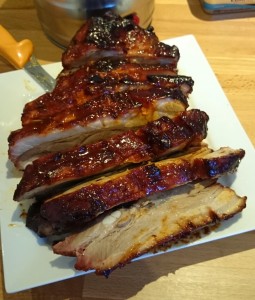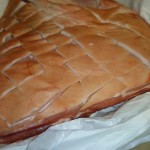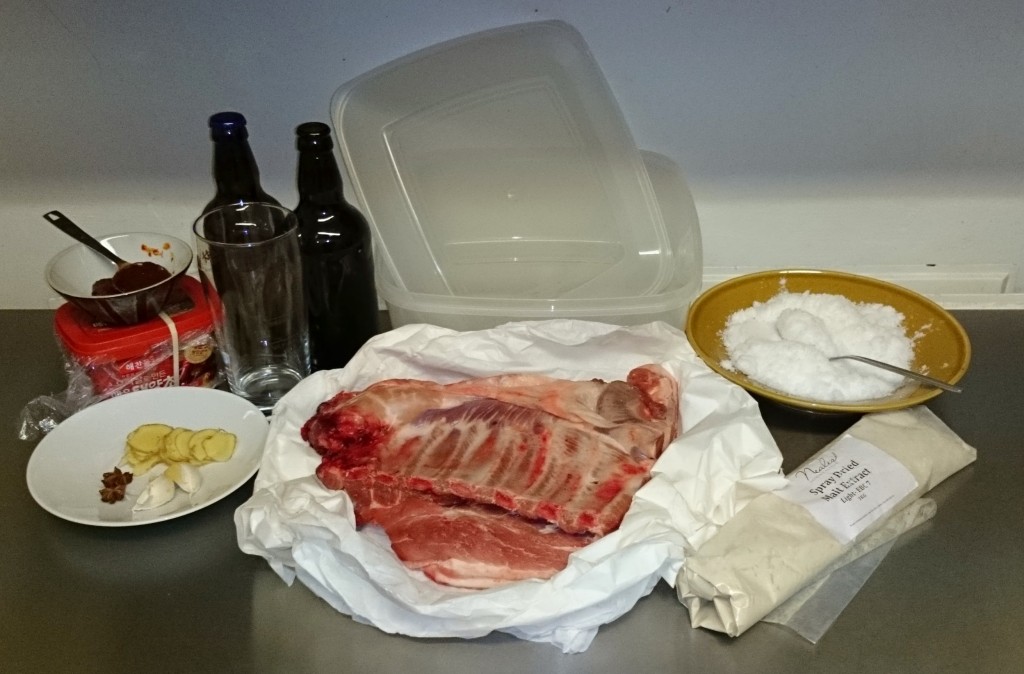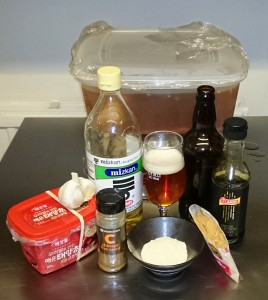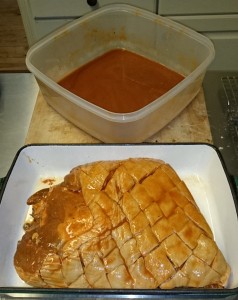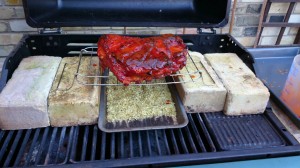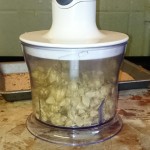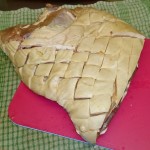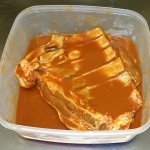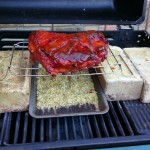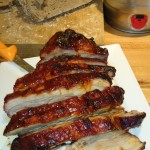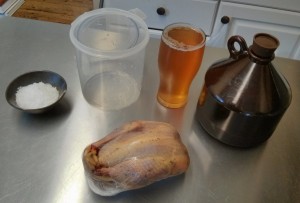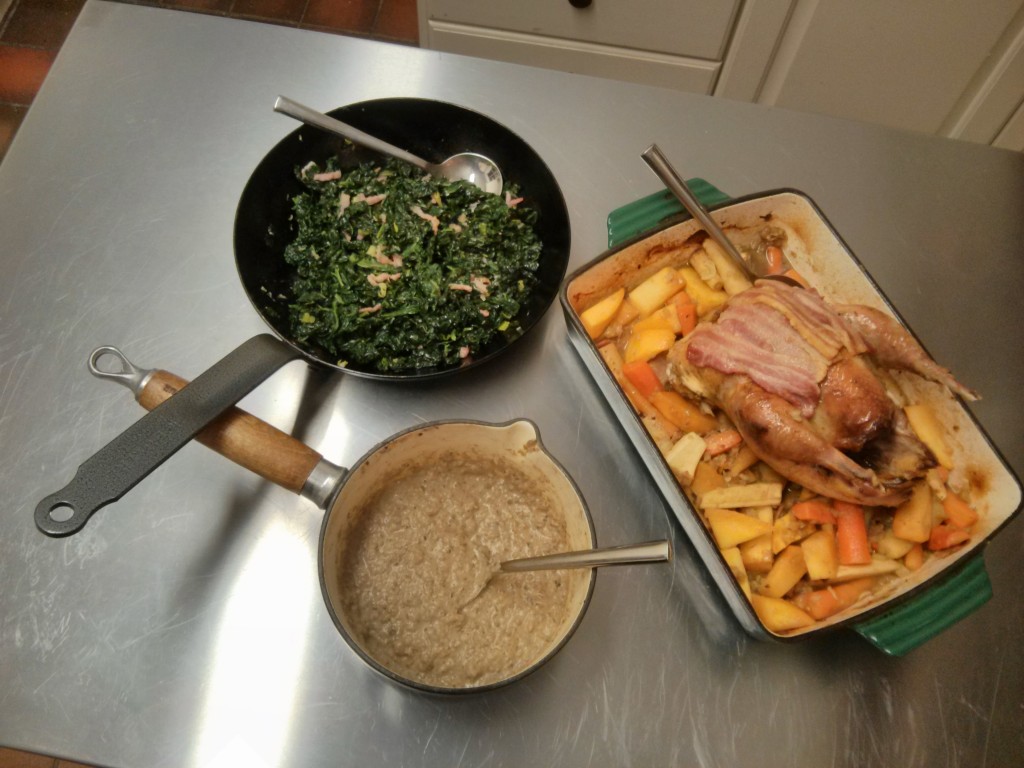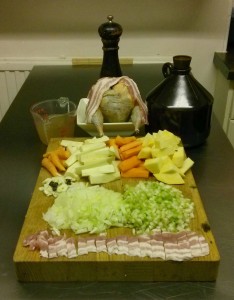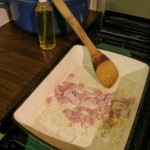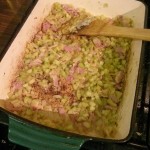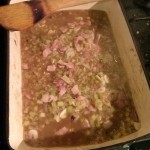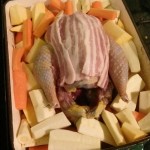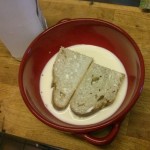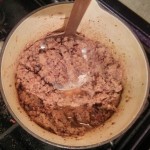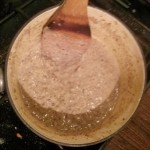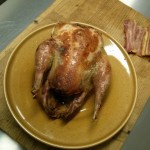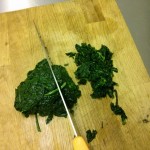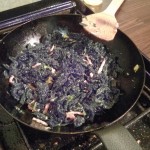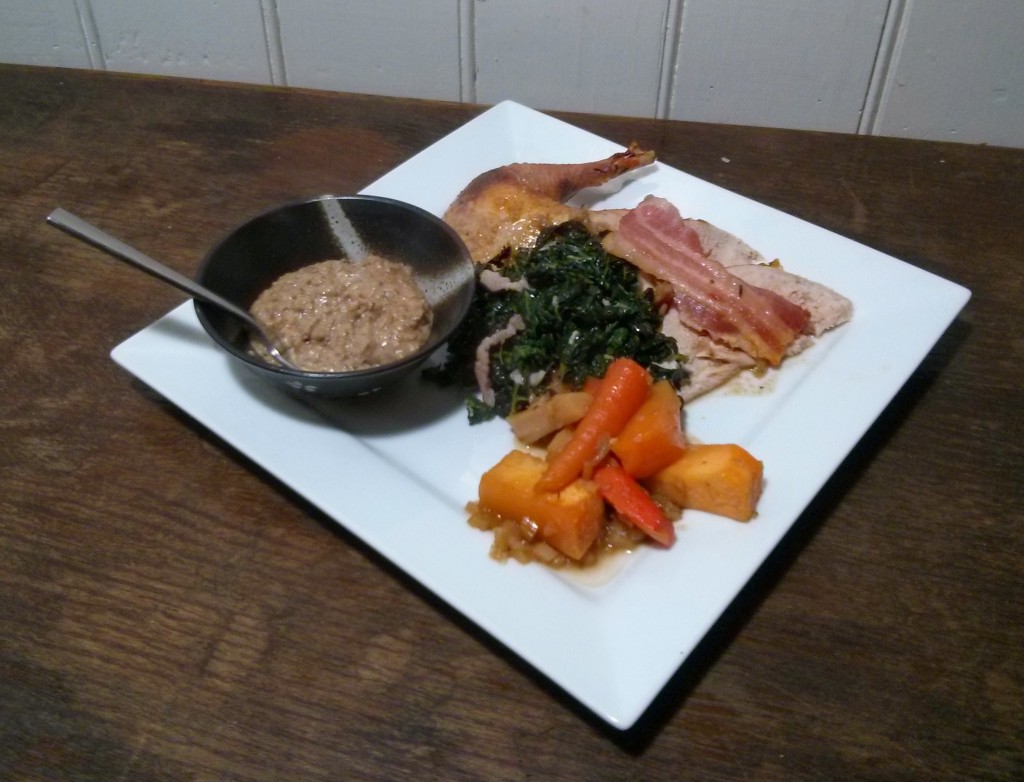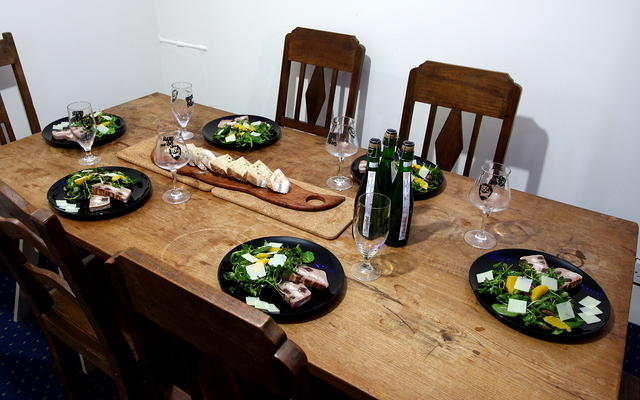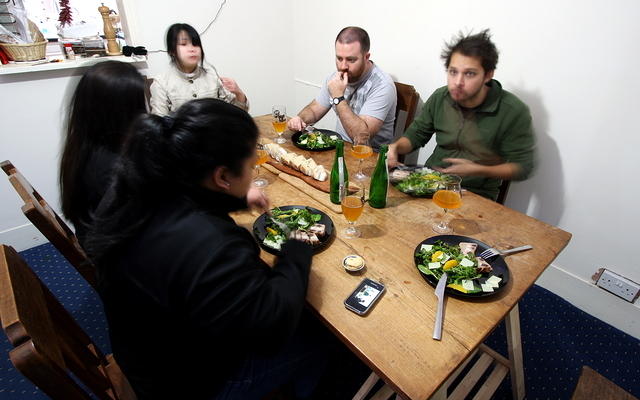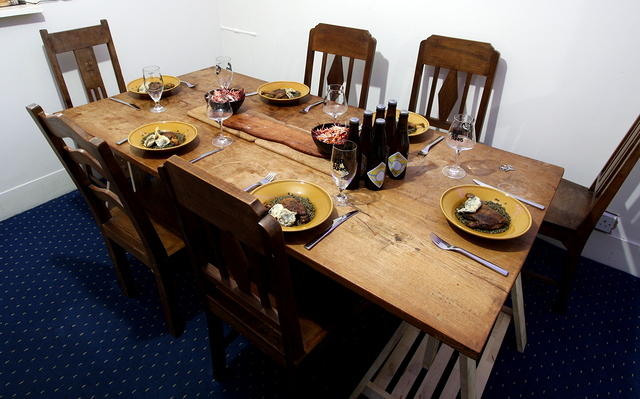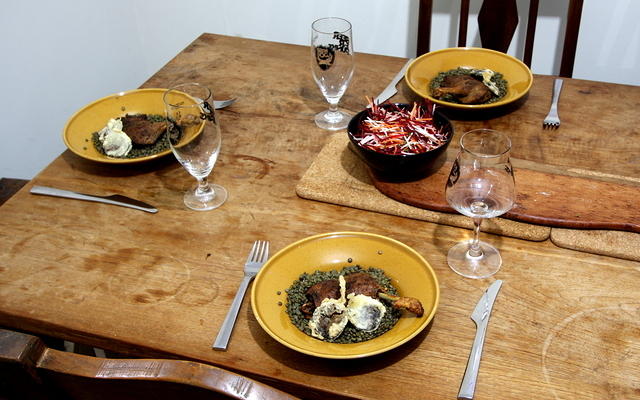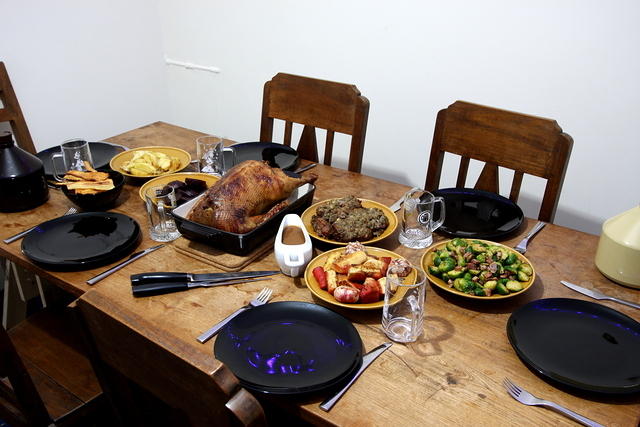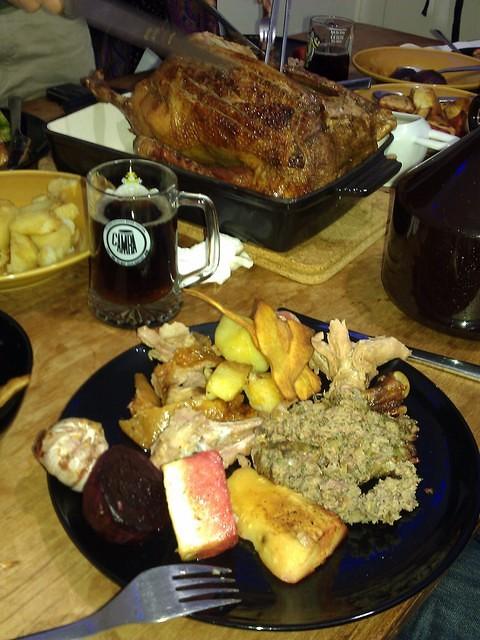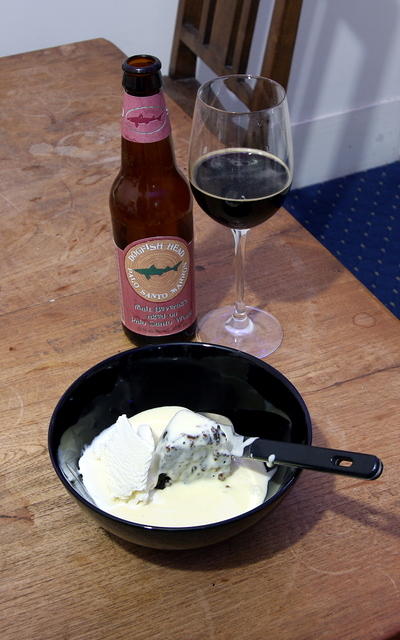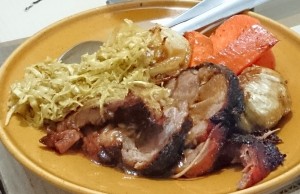 My previous beery recipe for a beery Char Sui(ish) Pork could be said to be somewhat… complicated. It’s a labour of love, a multi-stage dish designed for show & a special occasion. Sometimes you just want to slap together a hearty meal however – and roasts and stews are, in my mind, the ultimate bang-for-buck slap-up presentation dish. So on this wet winter evening, with a sad pint of the dregs of our Christmas mini-cask of delicious toasty-maltbomb BlackBar Porteur in front of me I was thinking roast lamb. We don’t have lamb very often despite it being my favourite of the traditional roasting meats – lamb is just so expensive. But it is that special time of year leading up to the end… or the start… depending on how you look at things. So we went and fetched ourselves a partially boned out 1.5kg rolled shoulder of British lamb.
My previous beery recipe for a beery Char Sui(ish) Pork could be said to be somewhat… complicated. It’s a labour of love, a multi-stage dish designed for show & a special occasion. Sometimes you just want to slap together a hearty meal however – and roasts and stews are, in my mind, the ultimate bang-for-buck slap-up presentation dish. So on this wet winter evening, with a sad pint of the dregs of our Christmas mini-cask of delicious toasty-maltbomb BlackBar Porteur in front of me I was thinking roast lamb. We don’t have lamb very often despite it being my favourite of the traditional roasting meats – lamb is just so expensive. But it is that special time of year leading up to the end… or the start… depending on how you look at things. So we went and fetched ourselves a partially boned out 1.5kg rolled shoulder of British lamb.
BlackBar Porteur – 4% – This porter was brewed for the Maypole pub. That had requested a ’porter’ for there beer festival which runs along side the Cambridge Beer Festival every year. So after a lot of reading and some wondering in the malt store i came up with this malty session porter. (From BlackBar website.)
The roast itself is typically simple. Preheat your oven to 220°C. Get together some herbs, the garden is pretty scant at this time of the year but I managed to gather some rosemary, a bit of dodgy looking sage, some fronts of fennel, and a little curly parsley. These herbs – rinsed and squeezed dry in a teatowel plus a couple of beefy cloves of garlic, the zest of a lime, and the chopped skin of a preserved lemon – are finely chopped before being pounded in a mortar & pestle with ½ teaspoon each of salt & pepper plus the juice of the lime and 4 tablespoons of rapeseed oil (or whatever you have to hand).
Death by 1000 cuts… that’s the treatment I give the lamb joint. Lots of little incisions just barely through the fat layer – this helps get flavour into the meat. Rub the oily mixture into the lamb – give it a good sensual massage, reserving a tablespoon of mixture to place under the joint. Pour the pint of beer around lamb – not over it.
Place in oven and sizzle until browning – this took 30 minutes in my pathetic oven but should take no more than 20 in a good one.
When the sizzle is done drop the oven temperature to 160°C, pull the lamb out of the oven and drizzle 2 tablespoons of honey over the joint. (It may help to warm the honey in hot water or a microwave to make it runny). The honey should evenly glaze the lamb and catch in the little divots made by the cuts. Pop the roast back into the oven.
Slow-roast at 160°C for 2 hours. At this point I popped myself out to the local pub and had a couple of pints. That’s what roasts & stews are all about :) relaxing whilst dinner cooks itself.
After an the 2 hours are up add your vegetables to the roasting dish, in my case: peeled sliced sweet potato, 2 whole heads of garlic, a couple of big carrots halved each way, a couple of halved onions. Baste the meat with fat from the roasting tin and then pop back into the 160°C oven for another 45 minutes – or until vegetables are tender.
Done. Before the 2 hour roast we had finely sliced some cabbage and sprinkled with salt. This was set aside while the roast was happening. When the roast was removed from the oven the cabbage was rinsed with water, spun in a salad spinner, and then sizzled & softened in lamb fat from the roasting dish plus a couple of tablespoons of tarragon vinegar.
The roast joint and vegetables were removed to a warmed plate. The pan juices had excess fat siphoned off with a turkey baster and were kept simmering on the stove. In a small saucepan 2 tablespoons of rapeseed oil and 2 tablespoons of plain flour were cooked together until sizzling for a minute before the pan juices were gradually poured in through a sieve. A little at a time whisking all the way. Initially it’ll seem very doughy – but once all the juices are combined in you should have a good thick gravy.
And we’re done… have some warmed plates ready and serve. Enjoy with a beer. Some take-home Adnam’s Tally Ho in this case – and the BlackBar Porteur made for the backbone of a damn fine gravy.
Ingredients Checklist
- 1 pint of dark not-too-bitter ale, a porter is usually a good choice
- A 1.5kg to 2kg roasting joint of lamb
- I used rolled shoulder, but leg is a luxury alternative, and if you’ve a big enough pan a whole bone-in shoulder will work beautifully.
- 4 tbsp chopped herbs/etc
- Fresh rosemary
- Fresh sage
- Fresh parsley
- Fresh fennel
- Fresh lime zest
- Rind of 1 preserved lemon
- 2 large garlic cloves
- 2 tbsp cold pressed rapeseed oil – or olive oil, or whatever you have
- Juice of 1 lime
- 1 tsp fresh ground black pepper
- 1 tsp ground seasalt
- Roasting vegetalbes
- 1 sweet potato – peeled, 3/4 inch slices
- 2 carrots – halved both ways
- 2 onions – halved
- 2 whole garlic heads – tips chopped off
- For cabbage:
- Cabbage leaves – fine sliced
- Salt
- Vinegar – cider, white wine, or tarragon, etc
- Roast lamb fat
Saison “Char Siu”(ish) Pork Belly
A classic Chinese pork dish… twisted and made utterly inauthentic.
Char siu is a very tasty Chinese BBQ treatment commonly used for pork. Typically prepared using pork neck this anise-spiced sticky-sweet red-hued barbecued pork is a staple of good Chinese restaurants back home in Australia. There’s a little clip about it on Australia’s SBS website here.
Thinking of the challenge to make something interesting for a Christmas get-together I found char siu floating into mind for some reason. We were supposed to bring something traditionally Christmassy/celebratory for our cultural backgrounds… as an Aussie atheist I see this as “free reign” – food back home is diverse, “fusion” is king, and Christmastime is HOT summer BBQ season. But… how could I add my own twist. Obviously: add beer. The beer I’ve chosen is a light and mildly spicy-sweet Saison with a pleasant farmy edge and just a twist of sourness. It’s my own Patio Grape Saison in fact. In addition I’ve used beer ingredients in the making of this dish too: malt extract in the brine & sauce and hops to smoke with. To make the dish even more luscious to suit the season I’ve also chosen to use pork belly rather than neck. Then to turn things up another notch I’m brining the belly for 24 hours prior to marinating for 12 hours in a char siu style marinade. The brine is about 50% beer, with some spices added, the char siu marinade is also made with the beer instead of vinegar and wine. The pork belly is slow-roast in the oven whilst being basted with the marinade – and is then lightly smoked with hops and applewood. My kitchen was nearly swallowed by some kind of hipster black-hole during the creation of this recipe.
Stage 1: Beer Brining a Belly
Equipment:
- 1 small saucepan
- Large plastic container that the pork belly can fit in
- Kitchen scales capable of at least 3kg
- Mortar & pestle
Ingredients:
-
~2kg piece of ribs-in pork belly
- deeply score the skin-side & score between the ribs – I’ve used a very meaty neck-end section of belly
- 1 litre Patio Grape Saison
- a low-IBU (~20IBU) saison-style beer – or try anything you fancy, so long as it isn’t too bitter, I’d avoid IPAs.
- 8 tbsp light DME
- Dried Malt Extract – available from homebrew shops and sometimes “Cooper’s” brand in Tesco homebrew sections. Or sub in the same amount of malt syrup, or molasses, or treacle, or honey, or brown sugar…
- 1 inch ginger – thinly sliced
- 2 good sized garlic cloves
- 2 stars of star anise
- 4 tbsp gochujang
- A really yummy hot & sweet paste available from Korean food stores but sometimes in other general Chinese/south-east-Asian stores. Sub in the same amount of tomato paste/concentrate if you cannot get the chilli paste and about 1 tsp of hot cayenne powder per tablespoon of paste.
- sea salt – depends, see calculation below
I’ve opted for a target 4% brine – to calculate the amount of salt weigh your pork belly in the brining container (~2200g in my case) and then fill with water until the belly is securely covered (about 1cm depth should do), remove the belly, and note the weight of the water (~2500g in my case). To calculate the amount of salt to use use 4% of the combined weight, i.e. (2500+2200)*0.04 = 188g. I should probably do other ingredients proportionally too… but so long as your pork belly is about 2kg the above should be good enough for replication. If repeating this myself I’d probably try a 3% target instead as the end product was just a little to the salty side. As ever do think about how to tweak it and make it your own, that’s the fun of cooking!
Crush the star anise in a mortar add ginger and garlic and pound them until roughly crushed. Put the salt, DME, garlic, ginger, star anise and chilli paste into a saucepan with 500ml of water. Heat until simmering and whisk vigorously until everything is combined and the salt dissolved. Put the remaining required cold water into the brining container (i.e. 2500ml – 500ml – 1000ml of beer = 1000ml cold water). To this add the hot brine mixture and then pour in the litre of beer.
Submerge the pork belly in the brine. Weigh down with a plate. Cover and pop into the fridge for 24 hours.
Stage 2: Beery Char Siu Marinade
This marinade is loosely based on char siu recipes found online, many recipes use Hoisin sauce but that’s a bit cheaty to me so I’ve replicated the flavour in this marinade by using Korean chilli paste and some Japanese miso. To add the beery edge to this marinade a large volume is made up of the same homebrew saison used in the brine plus the sweetener used is DME to add a Horlicks-like malty note.
Equipment needed:
- The container the pork was marinated in
- A small food processor to combine the marinade
- Tablespoon and teaspoon measures
Ingredients – good for ~2kg pork belly:
- 20 tbsp saison beer – see previous ingredients list
- 10 tbsp DME – see previous ingredients list
- 5 tbsp miso
- Easy to find in supermarkets. I’ve used shiro (white) miso – but would have used aka (red) if I’d had some handy.
- 5 tbsp gochujang – see previous ingredients list
- 2 tbsp soy sauce
- 2 tbsp rice vinegar
- 3 minced garlic cloves (10g)
- 1 tsp Chinese 5-spice
Pop all this into a small food processor and blitz until thoroughly combined.
Remove the pork belly from the brine, tip brine out, rinse belly, and place back into emptied container. Slather with marinade, working into any nooks and crevices.
Pop the lid on and put the container back in the fridge. This marinade should be on the pork for at least 12 hours. In this time flip the belly once or twice to help even marinating of the meat. (If you have a big enough ziplock or vac bag to put the belly and marinade in this is an even better way to do it.)
Stage 3: Slow Roast
Equipment:
- Oven – preheat to 150C
- Roasting dish that the belly fits into snugly
- Brush/baster for basting
- Small knife & a fork
Remove pork belly from marinade, let excess drip off, and place into a baking tray skin-side-up. Pop into the oven for 3 hours, basting lightly with some of the excess marinade every hour. (Just pull the whole thing out of the oven quickly and slap a bit of marinade on with a pastry brush.)
After three hours remove from the oven and carefully remove squares of skin that up until now have protected the underlying fat from burning. This is easy to do with a fork and a small knife. Baste thoroughly and pop back into the oven at 120C for another hour basting again after half an hour.
Stage 4: Lightly Smoke
The light smoking has been done to add a more “BBQed” effect that you can’t get using an oven. This smoking is entirely optional – or you may even be lucky enough to own the equipment to do that actual slow-roast in a smoker… in which case I envy you! If you are going to do the smoking as I have done it then be prepared and ready to go when the slow roast is complete.
Equipment – see photo:
- Decent size BBQ with hood
- A couple of bricks
- A small cheap/disposable metal tray
- A mesh rack to place belly on
You can buy smoking sawdust online, but I have some applewood logs from a local orchard and I made my own sawdust by sawing cuts into a log with a hand-saw. This is proper “slow food”! Just a couple of good handfuls of sawdust is enough. I’ve also added hops to the smoking fuel – the smell when the hops are smoking is amazing (and may cause neighbourly raised eyebrows), I’m not sure how much difference using hops specifically makes to the smoked flavour though. A couple of handfuls of hops are chopped thoroughly in a food processor.
The sawdust & chopped hops are placed in an old unused oven tray in my hooded gas BBQ. The pork is propped up on a wire rack a couple of inches above it, supported on a couple of bricks. A fresh lot of marinade is painted over the top-side and edges of the pork. The BBQ is turned on low until the sawdust starts to smoulder and then the hood is put down. I painted on a second lot of marinade after 10 minutes and gave the belly 20 minutes over smoke all up (by which point my smoking fuel was mostly blackened & spent.)
Serve!
While the smoking is happening I strain all the leftover marinade and pan juices into a saucepan and then boil this down to a double-cream thickness (as observed in a blow-cooled soup-spoon of sauce). This sauce was pretty salty – use sparingly, I drizzled just a little on the pork and put the rest in a gravy jug.
Stick the belly on a huge tray and give everyone a bun and a fork & knife! :) Two four six eight, BOG IN, don’t wait.
I’m pretty sure the “beery” element came through in the pork, albeit as part of a melange of BIG flavours so this wasn’t all about the beer. More an underlying saison-booziness. I made a sourdough based on the same saison to complement the pork – 80% white, 20% wholemeal, 50% liquid ingredient was the same beer used in the brine & marinade. It soaked up the rich marinade juices wonderfully.
Full Photoset
-
Brine Ingredients
-
Score deeply.
-
Marinade Ingredients
-
Use a plate…
-
Post-brining.
-
Marinating…
-
Into a roasting dish…
-
Log sawin’
-
Removing skin…
-
Hop choppin’
-
Smoke “ingredients”
-
Just out of the oven.
-
BBQ smoking setup
-
Smokin’!
-
Straight off the BBQ
-
Char-Siu-ish Pork Belly
-
Char-Sui-ish pork & sourdough
- Brine Ingredients
- Score deeply.
- Marinade Ingredients
- Use a plate…
- Post-brining.
- Marinating…
- Into a roasting dish…
- Log sawin’
- Removing skin…
- Hop choppin’
- Smoke “ingredients”
- Just out of the oven.
- BBQ smoking setup
- Smokin’!
- Straight off the BBQ
- Char-Siu-ish Pork Belly
- Char-Sui-ish pork & sourdough
Beer Brined Pheasant
… though I prefer the sound of “Beerinated Pheasant“.
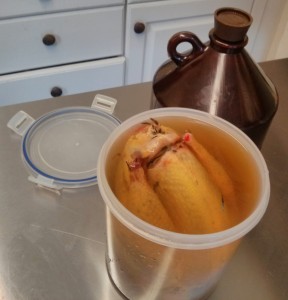
I picked up a couple of decent sized pheasant at my local butcher. It is the season… I do miss my old local in Hitchin where we knew a chap who kept us well supplied with pheasants, and other beasties, throughout the appropriate seasons. It feels a bit wrong buying oven-ready birds. But 8 quid for a brace without having to do the tedious plucking and messy gutting isn’t bad, you’ll pay more for a good chicken yielding a little less meat. While they’re “game” I don’t really think of pheasant as a “wild” bird. Almost all will have been cage raised, when you get them their crops are full of grain, and they really aren’t “gamey” – you need to give them at least a fortnight hanging to get any real decent gamey flavour. For the most part pheasant are best thought of as equivalent to a fine outdoor reared chicken, with an edge more flavour – especially around the fatty areas. If you have a good source then sometimes you’ll be lucky enough to get one of last season’s birds that has been roaming free for a year… deluxe! (Best Coq au Vin ever – or Coq au Bière!)
Anyway – the pheasant put me in mind of my old Poacher’s Pheasant Stew recipe, and I figured it was about time I did some beery cooking for this old blog thing. I’ve done beer brined chicken before and I figured: why not pheasant?
The Useful Content: Brining Your Bird
I work with a simple target 5% salt solution when brining like this, it’s hard to over-salt the bird at this strength but the solution is strong enough to have the desired affect. The recipe below is for just 1 litre of brine, as this plus one pheasant fits nicely into a 1.9 litre clip-seal container I have (see photo). You can easily make & add more brine if needed.
- Measure 50g of sea salt into a container.
- Add 100ml of hot water from a kettle and dissolve salt.
- Pour in a pint of beer – something not too bitter, a rich golden ale is good.
- Top up with cold water to make a litre of solution.
The Beer: The beer I chose for this was a take-home pint of The Brew Company “Simcoe“ (3.8%) from my local, a light ale with very grapefruity flavour notes (thus it must be craft!). I’d have preferred something with a bit more malt richness in it, but there were only a couple of other ales on and one was a stout (too dark IMO) and the other too bitter.
[Update 2014-03-15: I repeated this recipe using a bottle of Badger Blanford Flyer plus a bottle of Brain’s Barry Island IPA. Both beers I’d bought two of and discovered once was enough… too sweet. The brine worked brilliantly making for a very tasty pheasant with no hint of bitterness.]
The Salt: I used Maldon Sea Salt, posh stuff but the only thing I have handy that doesn’t have “anti-caking agent” in it. When brining a general rule of thumb that I’ve picked up from my reading is to find a “plain” salt without additives. I’ve never actually tried brining with a salt that has anti-caking agent in it though, I expect it’d probably work out fine.
Other Flavours: If you like add other flavour ingredients to this at the start with the salt. Bay leaves, juniper berries, a bit of rosemary, cracked black pepper, some crushed garlic… any of the “usual” aromatics. It helps if you give them a good crush or crumple. I’ve stuck with just beer because I was interested in how “beery” the bird would end up.
 Brine It: Pop your pheasant into a container or suitably sized zip-lock bag and cover with brine. Ensure it is fully submerged. I’ve put a small plastic container under the lid of the bigger one to force the bird into the brine. If you need more solution to cover your bird then make it up as 5:100 salt to water ratio. I.e. 500g (ml) or water (and/or beer) plus 25g of salt.
Brine It: Pop your pheasant into a container or suitably sized zip-lock bag and cover with brine. Ensure it is fully submerged. I’ve put a small plastic container under the lid of the bigger one to force the bird into the brine. If you need more solution to cover your bird then make it up as 5:100 salt to water ratio. I.e. 500g (ml) or water (and/or beer) plus 25g of salt.
Time: Give the bird at least 24 hours in the brine, I’ve done a chicken for 48 hours before and it turned out fine. In fact with a bigger bird 48 hours might be better than 24.
So… here’s one I prepared earlier… remove the bird from the brine and voilà! Brined pheasant. You can now do with this whatever you want. It’ll work jointed and braised, braised whole, or simply roasted. Basically, pick a suitable pheasant recipe that you like the sound of, roasting is where the brining really has the most marked positive results. Read on for what I did with my brined pheasant…
Roast beer-brined pheasant…
… with roast veg, garlicy bacon cavolo nero, and beery walnut bread sauce.
What you need… in general:
- Beer! Just a splash here and there – you can drink the rest. :)
(Avoid the very dark and very bitter.) - A bit of cooking oil, salt, and pepper as required.
- A whole beer-brined pheasant (as per above).
- Four and a half slices of unsmoked streaky bacon.
(Other half is used in the cavolo nero.) - A cup of chicken stock (game stock would be good, veal stock would do).
- Four cloves of garlic – thinly sliced.
- 6 juniper berries – well squashed.
- A couple of sticks of celery – 5mm dice.
- A medium brown onion – 5mm dice.
- Roasting veg, all peeled and diced into chunks about as big as the end of an average sized thumb! (Well, about an inch by half an inch.) Put them in a bowl and toss with a little olive oil (or other variety) until lightly coated. I used:
- Two medium parsnips
- Two carrots
- Half a swede
- A handful of baby carrots
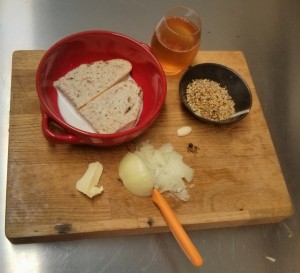 …for the beery walnut bread-sauce:
…for the beery walnut bread-sauce:
- A slice of good firm bread – I’ve used a pretty rustic sourdough.
- Some milk.
- Some walnuts – about 50g will do, chopped to “breadcrumb” consistency.
- A 20g knob of butter.
- Half a small brown onion – finely diced (2mm).
- A small garlic glove – crushed/grated/pasted.
- 2 juniper berries – squashed and chopped
 …for the garlicy bacon cavolo nero:
…for the garlicy bacon cavolo nero:
- One cavolo nero, or a suitable amount of leaves – with stems stripped out.
- Half a rasher of streaky bacon – finely sliced.
- About 20g of butter.
- A small clove of garlic – crushed/grated/pasted.
At least an hour in advance, put your firm bread into a bowl (cut/tear it if needed) and douse with just enough milk to soak it.
Pre-prep all the ingredients as described above.
Get the roast going: Preheat your oven to 230°C. Roughly chop two strips of streaky bacon and sizzle in a little oil. I do this directly in my cast iron baking dish. When the bacon is just beginning to brown toss in the diced onion and celery and sizzle this until the celery and onion is just lightly browning as well. At this point pour in the chicken stock and half a cup of the beer. Use the liquid to scrape off any browned-on residue, add the garlic and juniper berries, and bring this lot to simmering point. Now you can turn off the heat and place the pheasant in the middle of the roasting-tin breast-side-up. Bard the pheasant with a couple more strips of streaky bacon and pack the vegetables around the bird. Now into the oven with it – turning the oven down to 180°C immediately. Set a timer for 45 minutes.
Make the beery walnut bread-sauce: Lightly brown the walnut crumbs in a small saucepan, add the knob of butter and the onion. Cook on low heat for 2 minutes to just soften the onion. Add the garlic and juniper berries – which have both been crushed and finely chopped. Soften the spices for a minute before adding the milk-soaked bread and any milk with it, roughly tear this up. Heat and stir/mash to combine in the bread – the sauce should thicken considerably. Wet it with some additional milk if it isn’t a paste already. Add a splash of beer at a time, tasting as you go with an aim to get a beery flavour without undue bitterness. As you’re doing this you can also add salt to taste, which can balance the bitterness. As the sauce simmers it will continue to thicken, once you’re happy with the flavour imparted by the beer start adding milk instead in order to bring the sauce to a suitable consistency (which is up to you really, I aimed for a “heapable” paste). Put a lid on it and set it aside somewhere warm.
Turn your attention back to the roast: By this stage your roast has probably reached 45 minutes. Remove from the oven, I checked the internal temp deep between the leg and the body – 65°C, fine. Remove the bird from the baking tray and place aside on a warmed plate. Toss the vegetables in the roasting dish to get a bit of moistness on them and pop them back in the oven. They’ll probably need at least another 20 minutes until they’re suitably cooked. Optional: Take the bacon off, rub the breast with a little butter, place the bird under a low grill and carefully brown the breast. This isn’t just cosmetic, but it makes more of a cosmetic difference than a flavour difference – thus optional. Place the bird breast-side-down in its warmed bowl, putting the bacon next to it, cover with foil and put somewhere warm to rest. (I popped it into the top-oven, which is nicely warm while the veg are still roasting.)
Fry up the cavolo nero: Simple: steam the leaves in a colander over boiling water until “tender” (a couple of minutes). Let them cool a little before chopping roughly. In a fry-pan lightly brown the streaky bacon in a smear of oil. Pop in the nugget of butter and melt this then add the garlic. Let the garlic sizzled just a little, 15 seconds is plenty, then put the cavolo nero in and toss vigorously to coat the leaves in garlicy bacony buttery goodness. Done!
Time to “plate up”: The roast veg should be done by now, so we’re ready to serve. How you present this is up to you. I’d flip the bird back to breast-side-up, pop the bacon back on top, and take the lot to the table as-is and carve & dish-out to warmed plates at the table. The bread-sauce may need a little warming through before going to the table. On the plate I’ve simply put down a sample of each item, a small bowl of the bread sauce, and the beery juices from the pan with celery & onion are drizzled here and there.
 Serve, of course, with some good beer. If you’ve used take-home beer in the dish like I did it is probably a bit flat & dead by now if you still have any left. I served this dinner with Durham Brewery “Evensong” (5%)… which was a perfect match to a rich game dinner. The beer has a solid toasty backbone, it’s malt-forward and compliments both the season and this autumnal meal. My check-in note for the beer was: “Easy drinking amber ale. Very good with a bit of roast pheasant. Robust yet smooth flavour of maltloaf, cola, and summer hay.” The brined pheasant retained an excellent moistness thanks to the brining and had picked up a subtle beery note, too subtle perhaps, though it seemed more distinct when I tried some cold the next day. The beery notes were more to the fore in the bread sauce and pan juices and really are best described as “beery” – no fine nuances. It had tended a little to the bitter side in the pan juice, but this was no trouble as this was used sparingly anyway. Overall – a success. I’d like to try brining pheasant with some different beers to test the differences – something like my side-by-side IPA beer batter test, but I really need to invite some folk over to test the results for this one!
Serve, of course, with some good beer. If you’ve used take-home beer in the dish like I did it is probably a bit flat & dead by now if you still have any left. I served this dinner with Durham Brewery “Evensong” (5%)… which was a perfect match to a rich game dinner. The beer has a solid toasty backbone, it’s malt-forward and compliments both the season and this autumnal meal. My check-in note for the beer was: “Easy drinking amber ale. Very good with a bit of roast pheasant. Robust yet smooth flavour of maltloaf, cola, and summer hay.” The brined pheasant retained an excellent moistness thanks to the brining and had picked up a subtle beery note, too subtle perhaps, though it seemed more distinct when I tried some cold the next day. The beery notes were more to the fore in the bread sauce and pan juices and really are best described as “beery” – no fine nuances. It had tended a little to the bitter side in the pan juice, but this was no trouble as this was used sparingly anyway. Overall – a success. I’d like to try brining pheasant with some different beers to test the differences – something like my side-by-side IPA beer batter test, but I really need to invite some folk over to test the results for this one!
Enjoy!
3 Good Things: Apple, Venison, Bacon
This recipe has been devised in response to Hugh’s “Three Good Things” challenge. I am, of course, endeavouring to add beer as a sneaky fourth “good thing”. I’m adding it as a subtle addition — much the way the chefs in the TV episodes will gladly include brilliant oils, vinegars, stocks, and herbs without giving them a headline credit.
I recently found myself with a whole fallow deer carcass so I have a “glut” of venison at the moment. I figured apple + venison, a rich game meat and sweet apple… seems a pretty classic match. Amongst all the various cuts are a couple of chunky roasting muscles from each haunch (the “thick flank” I believe), this recipe makes use of one of these — it weighs in at about 850g.
I uhmmed and ahhed a lot about the third ingredient. Of all the extra bits I’d put with this what would be the natural one to highlight? Which one will shine the brightest? It became a toss–up between sage and bacon, and I settled on the bacon — adding extra punch by picking smoked bacon! Apples and pork, apples and bacon. Classic!
I’ve chosen to use Russet apples for their firm texture and slightly nutty savoury flavour. As luck would have it the day before the “apple challenge” was announced we’d picked up one of each variety of apple available at our local farmshop. We tasted all of these with some cheese, apple slices make a great alternative to crackers! So we’d got a little bit of prior research in to make an informed decision about the choice of apple. The farmshop, Willingham’s Bushel Box, is at the farm where the apples are grown — so they’re supremely local.
So, I present: Apple and bacon stuffed venison haunch joint, with apple gravy, and apple salad.
Stuffing
- 150g sausage meat
- 2 rashers smoked streaky bacon — roughly chopped
- 1 small Russet apple — 5mm dice
- sprig of roasmary
- sprig of sage
- 2 garlic cloves
- 6 juniper berries
- 3 tbsp of a rich red ale
- I’ve used Hardknott Infra Red, a 6% and particularly hoppy red ale from Cumbria and a long–time favourite beer of mine.
Crush up all the herbs and garlic in a pestle and mortar, loosen up with a little of the beer. With remaining beer rinse the pestle out into a bowl and add the sausage meat, diced apple, and diced bacon. Thoroughly combined, using hands of course, and ideally set aside for a while in the fridge so the flavours can develop.
Roast
- Stuffing mix above
- Venison “thick flank” — about 850g, or similar roasting cut
- 5 or 6 rashers of smoked streaky bacon
- 4 small Russet apples — quartered, unpeeled
- 6 fat garlic cloves
- Barding fat — pork back fat is the classic
- 250ml of the same red ale as used in the stuffing
- Some plain cotton string
- A large sprig of sage
Preheat oven to 220°C — or higher. (As I use very a heavy cast iron baking dish I pop that that in now too. My current oven is infuriatingly small, sticking a few kg of cold iron in it really sets the temperature back so I heat the pan up with the oven.)
Turn the joint of venison “ugly side up” and open it out along the grain of the meat. This is a combination of releasing the natural seams of the muscle and cutting into muscle butterfly–style. (I actually cut about 100g of meat out too to increase the size of the cavity. The offcuts are not wasted, they make a nice pre–dinner snack — dice it, mix it with left over stuffing: fry up as little patties!)
Line the middle of the opened out joint with about a strip of thinly sliced Russet apple rounds. Right down the middle lay two strips of streaky bacon, so they half lie out of the meat, put a “sausage” of just enough stuffing down the middle so that you can still comfortably wrap the meat around the lot (left over stuffing is expected — fry it up ad enjoy!) Wrap the stuffing by bringing the bacon up and over it. Lay the roast on 3 or 4 lengths of streaky bacon, which have in turn been laid on lengths of string of a suitable length to tie up the roast. It is difficult putting this to words, and it sounds more fiddly than it is by far! See the photos to get the idea:
Spread a bit of oil in the bottom of your roasting dish and place the roast into it bacon–side–up. Surround by wedges from 3 or 4 Russet apples, and the cloves of garlic which can just go in whole and unpeeled.
Into the oven for a sizzle! Do this until the outside has browned a little — 20 minutes in my case. Then reduce the heat to 180°C, baste with 3/4 of the beer, place the barding fat on top…
…and continue to roast until you reach an internal temperature of around 65°C (40 more minutes in my case). Remove from the oven and set the roast aside on a warm plate and cover with some tinfoil while it rests.
Now the apple gravy! This couldn’t be simpler. Carefully pour as much of the fat out of the roasting tin as you can, this can be discarded (or put to another use if you’re really thrifty). Remove everything remaining from the pan and place it into a food mill. Use the remaining beer to wash all you can out of the pan too. Mill it. Done! It should be a good thick consistency and beautiful rich, roasty, caramelised, beery, apple flavour. (It took quite some effort to stop myself just standing there eating this with a spoon!)
Salad
- 2 small Russet apples — medium dice
- Half a medium brown onion — fine dice
- 1 tbsp Rapeseed oil
- 1 tbsp Cider vinegar
- Pepper/Salt
- 3 or 4 fresh sage leaves — finely shredded
This piquant little apple salad cuts through the other rich roasty flavours in the plate — giving the whole meal a nice crisp lift. Simply toss it all together, adding pepper & salt to taste.
Serve!
Slice roast, place on warmed plate, apply gravy, add a pile of fresh apple salad. Enjoy! With a glass of Hardknott’s excellent Infra Red… duh :)
A Beery Christmas
Just before Christmas I wrote about pairing beers with the various courses of my Christmas day menu. The day is now well in the past – but I’ve finally sat down and written up a quick summary of how it went. In a nutshell: well.
1st Course
Terrine of sweetbreads, black pudding, and spiced pork mince
Served with a salad of rocket, fresh orange, Kalamata olives, and shaved Pecorino Romano – with a zesty orange vinaigrette
1st Beer: Lambic/Tripel
Brouwerij Loterbol “Tuverbol” (2007) – 10.5% (Belgium)
The Tuverbol with its spicy and zesty orange notes matched the food brilliantly, especially the zesty orange vinaigrette. The lambic qualities acted as a crisp and cleansing counterpoint to the rich solidity of the cold terrine, while the beer had enough body to not seem too thin in contrast.
Everyone seemed to approve of this pairing.
2nd Course
Whole confit duck leg
Served with tempura black pudding pieces, lemony puy lentils, and a salad of julienne celeriac, carrot, and beetroot
2nd Beer: Witbier
Beer: Brouwerij ‘t IJ “Scharrel IJwit” (Netherlands)
This pairing wasn’t as successful as the first one. The beer was light, refreshing, and lemony and matched lemony flavours used in the dish. Unfortunately it didn’t really stand up to the in-your-face richness of the confit and black pudding. It was effectively drowned out – despite being quite a tasty witbier when drunk in isolation.
On reflection I think this beer would be a better match for a white fish dish.
In a future rendition of this pairing I think I’d try for something more hoppy and herbal. Something along the lines of BrewDog’s 5AM Saint, Moor’s JJJ IPA, or HardKnott’s Infra-Red. I could also, perhaps, use the same beer in the “tempura” batter used for the black pudding.
3rd Course
Roast Goose
Served with the usual bits and bobs: a pear, currant, and walnut “stuffing”; roast vegetables; parsnip chips; something green perhaps …
3rd Beer: Real Ale?
Ringwood “Old Thumper” – 5.6% (UK)
Tring’s “Colley’s Dog – 5.2% (UK)
I changed my mind and decided to go with a real cask conditioned ale for the main course instead of the bottled Old Thumper from Ringwood. My choice of ale was the ever-popular Colley’s Dog from Tring Brewery.
This really worked as expected, a good rich ale with a good rich meal. No pussyfooting about!
The caramel/malt body of the Colley’s Dog held up well against all the rich roasty flavours of the meal. With better preparation I’d have liked to have used a bit of the Colley’s dog in the gravy, maybe next time!
Palate cleanser
Alvinne “Melchior Calvados Barrel Oak Aged” – 11.5% (Belgium)
We sipped this while relaxing and watching Tim Burton’s “The Nightmare Before Christmas”.
Dessert
Traditional Christmas Pudding made with Nethergate Old Growler Porter
Possibly served with a whisky crème-anglaise and vanilla-bean icecream
Dessert Beer
Dogfish Head “Palo Santo Marron” – 12% (USA)
This was a perfect combination, as planned the beer complimented dessert like a rich and beery chocolate sauce. We didn’t actually have dessert until about 02:30 on Boxing Day though. It was a long day of cooking, eating, and gourmet beerination!
Conclusion
I declare the matching of food and beer for Christmas experiment a success. Of course, if this meal were to be repeated there are certainly some refinements that could be made. Beer has been used here in a considered way, no swigging boxes of bland fizzy crap; rather: a careful study of flavours and textures. As you can see from the photo above we didn’t drink copious quantities of alcohol on the day.
I will definitely do this again, and also put more thought toward everyday drinking of beer alongside food.

